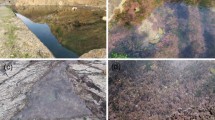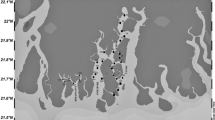Abstract
The US Antarctic Marine Living Resources (AMLR) program has, since 1990, conducted annual surveys from early January through mid-March in a large sampling grid around Elephant Island, Antarctica. Approximately 100 hydrographic stations were occupied twice during each field season, with physical, chemical, optical, and biological data acquired from the surface to 750 m depth or to within 10 m of the bottom at shallower stations. During these 14 years, most of the stations in pelagic waters to the northwest of Elephant Island had very low chlorophyll-a (Chl-a) concentrations (<0.2 mg m−3) in the upper mixed layer (UML) of ~45 m, but a deep chlorophyll-a maximum (DCM) existed between 50 and 100 m, with a peak at approximately 75 m. This was in contrast to adjacent stations which had higher Chl-a concentrations (approximately 1.0 mg m−3) in the UML and no DCM. We provide evidence that the higher Chl-a concentrations that occur at depths of 50–100 m result from increased photosynthetic activity and not from a passive sinking of cells from the UML or by the intrusion of Chl-a rich coastal waters. Data to support this conclusion include (1) elevated dissolved oxygen concentrations between 50 and 100 m, (2) evidence of active photosynthesis at the depth of the DCM as indicated by increased natural upwelling radiation at 683 nm, and (3) water samples obtained from the DCM at 75 m and incubated under simulated conditions of temperature and light had assimilation numbers of approximately 1.0–1.5 mg carbon fixed per milligram Chl-a per hour. DCMs occur in the same depth range as the temperature minimum layer (TML) (the winter remnant of Antarctic surface water, AASW), which is known to have elevated concentrations of inorganic nutrients essential for growth of phytoplankton. Our data indicate that a DCM develops as a result of (1) depletion of iron (Fe) in the UML with the onset of the summer season, and (2) growth of phytoplankton in the TML where both Fe concentrations and solar irradiance levels are high enough to permit an increase of phytoplankton biomass.







Similar content being viewed by others
References
Amos AF (2001) A decade of oceanographic variability in summertime near Elephant Island, Antarctica. J Geophys Res 106:22401–22423
Baar HJW de, de Jong JTM (2001) Distributions, sources and sinks of iron in seawater. In: Turner DR, Hunter KA (eds) The biogeochemistry of iron in seawater. Wiley, New York, pp 123–253
Boyd PW, et al (2000) A mesoscale phytoplankton bloom in the polar Southern Ocean stimulated by Fe fertilization. Nature 407:695–702
Chamberlin WS, Marra J (1992) Estimation of photosynthetic rate from measurements of natural fluorescence: analysis of the effects of light and temperature. Deep-Sea Res 39:1695–1706
Chamberlin WS, Booth CR, Kiefer DA, Morrow JH, Murphy RC (1990) Evidence for a simple relationship between natural fluorescence, photosynthesis and chlorophyll in the sea. Deep-Sea Res 37:951–973
Chisholm SW, Morel FMM (1991) What controls phytoplankton production in nutrient-rich areas of the open sea? Limnol Oceanogr 36:1507–1970
Cullen JJ, Eppley RW (1981) Chlorophyll maximum layers of the Southern California Bight and possible mechanisms of their formation and maintenance. Oceanol Acta 4:23–32
Deacon GER (1937) The hydrology of the Southern Ocean. Discov Rep 15:1–124
El-Sayed SZ (1988) Seasonal and interannual variabilities in antarctic phytoplankton with reference to krill distribution. In: Sahrhage D (ed) Antarctic Ocean and resources variability. Springer, Berlin Heidelberg New York, pp 101–119
Estrada MC, Marras M, Latasa E, Berdalet M, Delgado M, Riera T (1993) Variability of deep chlorophyll maximum characteristics in the Northwestern Mediterranean. Mar Ecol Prog Ser 92:289–300
Goldman JC (1980) Physiological processes, nutrient availability, and the concept of relative growth rate in marine phytoplankton ecology. In: Falkowski P (ed) Primary productivity in the sea. Plenum, New York, pp 179–194
Goldman JC, McCarthy JJ, Peavey DC (1979) Growth rate influence on the chemical composition of phytoplankton in oceanic waters. Nature 279:210–215
Gordon HR (1979) Diffuse reflectance of the ocean: the theory of its augmentation by chlorophyll-a fluorescence at 685 nm. Appl Opt 18:1161–1166
Helbling EW, Villafañe V, Holm-Hansen O (1991) Effect of Fe on productivity and size distribution of Antarctic phytoplankton. Limnol Oceanogr 36:1879–1885
Hewes CD, Holm-Hansen O, Sakshaug E (1985) Alternate carbon pathways at lower trophic levels in the Antarctic foodweb. In: Siegfried WR, Condy PR, Laws RM (eds) Antarctic nutrient cycles and food webs. Springer, Berlin Heidelberg New York, pp 277–283
Hofmann EE, Klinck JM, Lascara CM, Smith DA (1996) Water mass distribution and circulation west of the Antarctic Peninsula and including Bransfield Strait. In: Ross RM, Hofmann EE, Quetin LB (eds) Foundations for ecological research west of the Antarctic Peninsula. American Geophysical Union, Washington, pp 61–80
Holm-Hansen O, Mitchell BG (1991) Spatial and temporal distribution of phytoplankton and primary production in the western Bransfield Strait region. Deep-Sea Res 38:961–980
Holm-Hansen O, Riemann B (1978) Chlorophyll a determination: improvements in methodology. OIKOS 30:438–447
Holm-Hansen O, Lorenzen CJ, Holmes RW, Strickland JDH (1965) Fluorometric determination of chlorophyll. Cons Perm Int Explor Mer 30:3–15
Holm-Hansen O, Mitchell BG, Hewes CD, Karl DM (1989) Phytoplankton blooms in the vicinity of Palmer station, Antarctica. Polar Biol 10:49–57
Holm-Hansen O, Amos AF, Silva N, Villafañe V, Helbling EW (1994) In situ evidence for a nutrient limitation of phytoplankton growth in pelagic Antarctic waters. Antarct Sci 6:315–324
Holm-Hansen O, Hewes CD, Villafañe VE, Helbling EW, Silva N, Amos AF (1997) Distribution of phytoplankton and nutrients in relation to different water masses in the area around Elephant Island, Antarctica. Polar Biol 18:145–153
Hoppema M, de Baar HJW, Fahrbach E, Hellmer HH, Klein B (2003) Substantial advective iron loss diminishes phytoplankton production in the Antarctic zones. Global Biogeochem Cycle 17:1025.01–1025.09
Kiefer DA, Kremer JN (1981) Origins of vertical patterns of phytoplankton and nutrients in the temperate, open ocean: a stratigraphic hypothesis. Deep-Sea Res 28A:1087–1105
Kiefer DA, Olson RJ, Holm-Hansen O (1976) Another look at the nitrite and chlorophyll maxima in the central North Pacific. Deep-Sea Res 23:1199–1208
Kiefer DA, Chamberlin WS, Booth CR (1989) Natural fluorescence of chlorophyll a: relationship to photosynthesis and chlorophyll concentration in the western South Pacific gyre. Limnol Oceanogr 34:868–881
Marra J, Dickey T, Chamberlin W, Ho C, Granata T, Kiefer D, Langdon C, Smith R, Baker K, Bidigare R, Hamilton M (1992) The estimation of seasonal primary production from moored optical sensors in the Sargasso Sea. J Geophys Res 97:7399–7412
Marra J, Chamberlin WS, Knudson C (1993) Proportionality between in situ carbon assimilation and bio-optical measures of primary production in the Gulf of Maine in summer. Limnol Oceanogr 3:231–238
Martin JH, Fitzwater SE, Gordon RM (1990a) Iron deficiency limits phytoplankton growth in Antarctic waters. Global Biogeochem Cycle 4:5–12
Martin JH, Gordon RM, Fitzwater SE (1990b) Iron in Antarctic waters. Nature 345:156–158
Measures CI, Vink S (2001) Dissolved Fe in the upper waters of the Pacific sector of the Southern Ocean. Deep-Sea Res II 48:3913–3941
Owrid G, et al (2000) Spatial variability of phytoplankton, nutrients and new production estimates in the waters around Svalbard. Polar Res 19:155–171
Rönner U, Sörensson F, Holm-Hansen O (1983) Nitrogen assimilation by phytoplankton in the Scotia Sea. Polar Biol 2:137–147
Sañudo-Wilhelmy SA, Olsen KA, Scelfo JM, Foster TD, Flegal AR (2002) Trace metal distributions off the Antarctic Peninsula in the Weddell Sea. Mar Chem 77:157–170
Siegel V (1988) Concept of seasonal variation of Krill (Euphausia superba) distribution and abundance west of the Antarctic Peninsula. In: Sahrhage D (ed) Antarctic Ocean and resources variability. Springer, Berlin Heidelberg New York, pp 219–230
Sievers HA, Nowlin WD (1988) Upper Ocean characteristics in Drake Passage and adjoining areas of the Southern Ocean, 39°W–95°W. In: Sahrhage D (ed) Antarctic Ocean and resources variability. Springer, Berlin Heidelberg New York, pp 57–80
Silva SN, Helbling EW, Villafañe V, Amos AF, Holm-Hansen O (1995) Variability in nutrient concentrations around Elephant Island, Antarctica, during 1991–1993. Polar Res 14:69–82
Stein M (1988) Variation of geostrophic circulation off the Antarctic Peninsula and in the Southwest Scotia Sea, 1975–1985. In: Sahrhage D (ed) Antarctic Ocean and resources variability. Springer, Berlin Heidelberg New York, pp 81–91
Sverdrup HU (1953) On conditions for the vernal blooming of phytoplankton. J Cons Int Explor Mer 18:287–295
Veldkamp H (1976) Continuous culture in microbial physiology and ecology. Meadowland, Durham
Westerlund S, Öhman P (1991) Iron in the water column of the Weddell Sea. Mar Chem 35:199–217
Yamaguchi Y, Shibata Y (1982) Standing stock and distribution of phytoplankton chlorophyll in the Southern Ocean south of Australia. Trans Tokyo Univ Fish 5:111–128
Zhou M, Niiler PP, Hu J-H (2002) Surface currents in the Bransfield and Gerlache Straits, Antarctica. Deep-Sea Res I 49:267–280
Acknowledgements
This work was funded through the US AMLR program, administered by the Antarctic Ecosystem Research Division at NOAA’s Southwest Fisheries Research Center, La Jolla, California. Special funds were also provided by NOAA/AMLR to compile a rational data base of all our data to present, and without which this manuscript could not have been accomplished. Reiner Schlitzer produced Ocean Data View, which was a most invaluable tool in our analyses of water column profile data. We thank all officers and crews of the R.V. “Surveyor” and R.V. “Yuzhmorgeologiya”, for their excellent help during all field operations, and also all other AMLR personnel who assisted us on board ship. Special thanks are extended to Tony Amos, who acquired and processed the physical oceanographic data. We also thank Mati Kahru and B. Greg Mitchell for providing us with solar irradiance data acquired with their free fall optical profiling instrumentation. We also thank three anonymous reviewers for their helpful comments.
Author information
Authors and Affiliations
Corresponding author
Rights and permissions
About this article
Cite this article
Holm-Hansen, O., Hewes, C.D. Deep chlorophyll-a maxima (DCMs) in Antarctic waters. Polar Biol 27, 699–710 (2004). https://doi.org/10.1007/s00300-004-0641-1
Received:
Revised:
Accepted:
Published:
Issue Date:
DOI: https://doi.org/10.1007/s00300-004-0641-1




